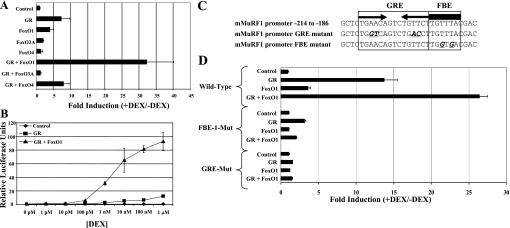Fig. 4.
DEX-activated GR synergizes with FOXO1 to potently induce the MuRF1 promoter. A: HepG2 cells were transfected with the pGL3-MuRF1 promoter (−500) reporter construct, SV40-Renilla luciferase reporter construct, pSG5-GR, and/or pcDNA3-FOXO1, pcDNA3-FoxO3A, or pcDNA3-FOXO4. Cells were treated with or without 1 μM DEX for 24 h. Firefly luciferase activities in cell extracts were normalized to Renilla luciferase activity to control for variations in transfection efficiency. Fold induction was obtained by dividing values from DEX-treated samples by the mean of values from matched untreated samples. Each point was done in triplicate, and errors reflect SD. B: HepG2 cells were transfected with pGL3-MuRF1 promoter (−500), SV40-Renilla, and pBluescript as filler DNA (control) and either GR (GR) or GR and FoxO1 (GR + FoxO1) expression vectors. Twenty-four hours posttransfection, cells were treated with the indicated DEX concentration and incubated overnight. Each point was done in triplicate. C and D: mutation of either the GRE or the FBE is sufficient to abolish DEX-induced MuRF1 promoter activity. HepG2 cells were transfected with either the wild-type MuRF1 promoter construct (−500) or MuRF1 promoter constructs that have either the GRE mutated (GRE-Mut) or the FBE mutated (FBE-Mut) as shown in C in combination with expression vectors for FoxO1 and/or GR as indicated. The cells where then treated and assayed for luciferase activity as in A.

